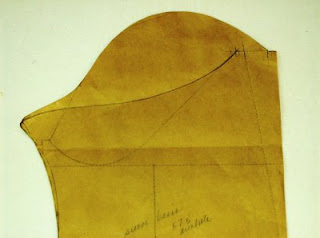 More about sleeves.
More about sleeves.Have you ever noticed that a poor guy wearing his suit cannot lift his arm up without the sleeve cutting into his upper arm and then dragging the whole jacket up too?
Well maybe it's not one of your everyday things to notice, but take a look sometime at how restricting a modern jacket is.
The armholes are cut really low for one thing and the sleeves have a very high depth of crown.
This combination conspires to constrict.
The worst time we have is when commercial jackets are purchased- especially for a dance show - and then we get the lovely job of trying to do something about the restrictive fitting of the sleeves.Yuck! We usually end up cutting a separate gusset and then opening up the underarm to sew it in. Tedious work to be sure. (It usually entails cutting up a spare jacket too!)
When we need to have movement in a suit sleeve we are more likely to construct a "grown-on" gusset sleeve like the pattern in the picture above. Along with a higher cut armhole, this allows for raising your arm, yet for the most part when the arm is at rest in a natural position you don't notice it. The gusset starts on the top sleeve just about where the arm naturally meets the body, and continues on the undersleeve, eventually joining in along the original undersleeve line.
It looks strange but it works.


















